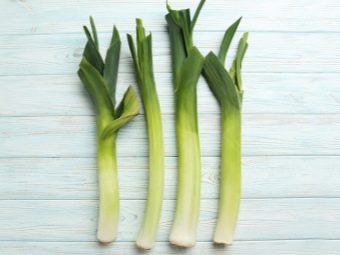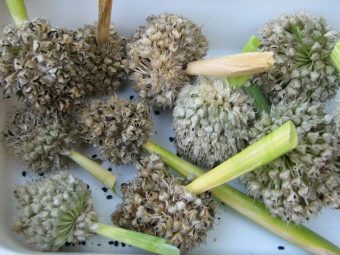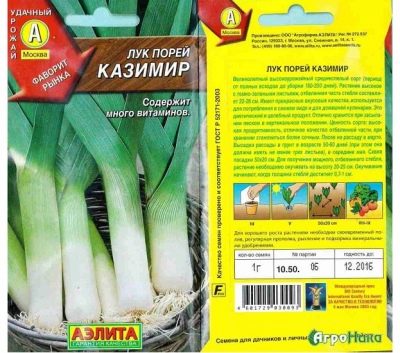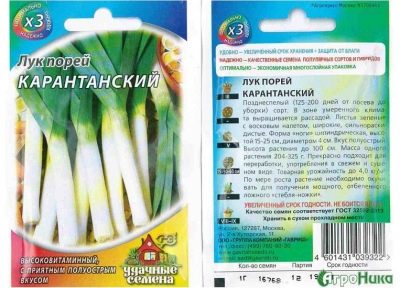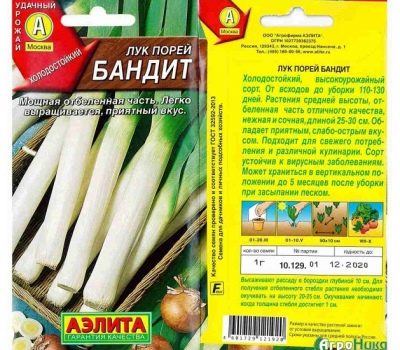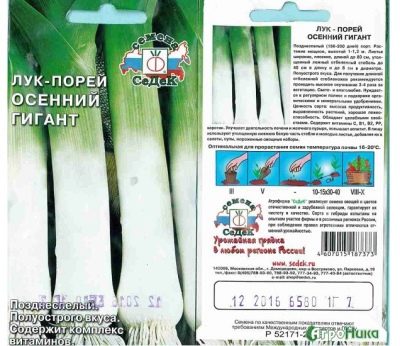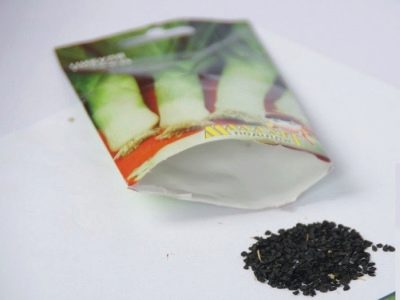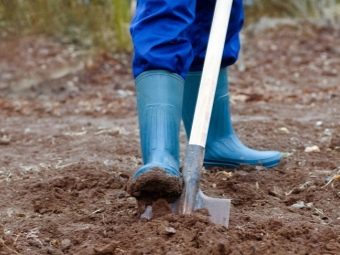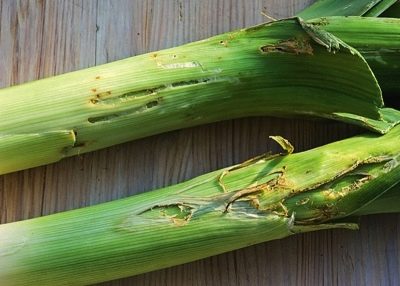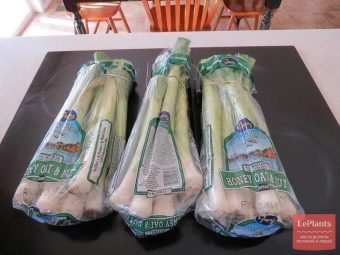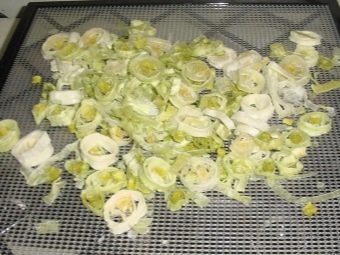Features and cultivation of leeks
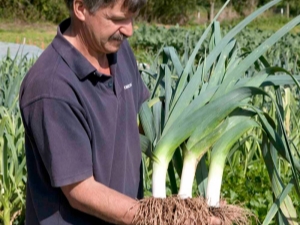
Growing different crops in the garden can be a very exciting experience.But getting a good harvest is possible only under one condition: full knowledge of the characteristics of a particular plant. This requirement applies to leeks.
Description
According to the botanical classification of leeks among the onion crops. According to the same culinary, it is rather a category of spices. In Europe, this plant spread during the existence of ancient Rome. But even earlier, leek, whose wild ancestors grew on the eastern shores of the Mediterranean, was mastered in Egypt and Judea. The height of the stem of a vegetable varies from 40 to 90 cm, the color of the leaves is also variable, it happens not only green, but with a bluish tint. Inflorescence, including pink and slightly white flowers, looks like an umbrella. Bulb length increased, reproduction occurs at the expense of seeds.
Two types of culture have been introduced into culture - leeks for summer and winter; the whitish structure of the vegetable has a gastronomic significance.
Harvesting is possible twice a year: at the end of spring and in autumn or in the first month of winter. If the meteorological situation is favorable, the collection may take longer. The leek of the cold season is completely allowed to leave in the field conditions in a rounded form. But the characteristics of the harvested vegetables, including taste, are lost in the house after 30 days. Inside the leek, the concentration of proteins is greater than in a simple onion.
The specific aroma is created by essential oils in which sulfur is present (per 100 g of the green mass of these oils is not more than 3 mg, but this is enough). Interestingly, the same oils prevail as in the composition of garlic.
Other components of a leek are the following:
- protein substances;
- sugary ingredients;
- element P;
- element K;
- sodium and iron;
- carotene and magnesium;
- vitamins B1, B2 in significant amounts;
- Vitamins C, PP in slightly lower concentrations.
Under the action of essential oils, appetite is forced, the function of the intestine and gall bladder is stabilized. There is increased urine extraction, the benefits of gout and rheumatism are beyond doubt. Cooks focus on other, of course, plant parameters. Leek has a distinctive onion flavor, but the taste effect is thinner than that of a regular turnip. A number of gourmets prefer the recipe of onion fried with vegetable oil, breaded with dried bread.
And also leek is often added to such dishes as:
- scrambled eggs and scrambled eggs;
- sauces;
- raw salads;
- mashed potatoes;
- various pastes;
- pickled leek.
All this means that the perennial onions of this kind are simply underestimated by gardeners. The possibilities for breeding it are quite large, but they are still used insufficiently. It should be noted that in practice, leek is cultivated rather as an annual vegetable. The plant is valuable for its false bulb (in fact, it is a leg), and you can also put young leaves on the table. The onion can grow up to 450 mm in height and have a diameter of up to 80 mm.
Leek leaves can be confused with garlic, but it's easy to correct the error, considering that they are longer and wider. Interestingly, onions during storage only increases the concentration of nutrients in the fruit section (they continue to come from the leaves). If you plant the overwintered leek, he will continue the growing season and throw away the developed arrow, topped with a ball. Culture blooms in most cases in the second half of summer and in September.
The time of collecting seeds comes approximately from October 15, they can be stored for 2 or 3 years without fear of germination.
Properties
To understand the reviews about leech, as well as to assess where the true, and where the false information, you need to pay attention to how it affects the body. Due to the significant amount of coarse fibers, this bow forcing the bowels to work. Contrary to popular belief, the consumption of green feathers does not lead to flatulence, does not suppress the beneficial microflora. Magnesium and phosphorus stabilize the activity of the nervous system.And folic acid is useful in that it improves the nervous system that is formed in unborn children.
Leek can be used as an additional remedy for inflammations of various nature. It is not only about gout, but also about arthritis and arthrosis. According to recent medical research, the systematic use of leek reduces the risk of neoplasms and contributes to curbing their growth.
It is important: if portions of nicotine also systematically enter the body, the opposite effect occurs - carcinogenic - effect. With regard to the presence of iron, it is not so much as in other plants, but the form of the substance is much better for assimilation, which is further enhanced by vitamin C.
Thanks to potassium, leek juice stabilizes the work of the heart and blood vessels. Caution: this should not replace systematic prevention and treatment. In addition, the dose must be selected very carefully. It is noted that onion fibers already in the process of digestion block “bad” cholesterol. This means that the threat of atherosclerosis and vascular blockage is significantly reduced. Therefore, leeks should be consumed in conjunction with fatty foods, as well as with copious portions of even lean meat. Moreover, it is a pleasant combination.
Like other types of onions, leek has a pronounced antibacterial effect. It helps prevent inflammation of the upper respiratory tract. Ascorbic acid promotes the proper synthesis of collagen, which improves the appearance of the skin. More importantly, the same collagen is up to 50% of all human solid tissues in different organs.
If you refer to the literature published in the last century, you can find a statement there: leek is harmful only if it is excessive intake. But recent medical studies have shown that some people should beware of it yet, first of all, this applies to people who are allergic to nickel and its compounds (which are contained in large doses in the stems and leaves of a vegetable). It is also noted that it may excessively increase the acidity of the gastric environment.
If diarrhea, especially strong and lasting for a long time, suddenly broke out, it is better not to eat leek. Moreover, irritation of the intestinal surface with hard fibers only aggravates the condition, postpones recovery. Caution should be taken to this vegetable patients with urolithiasis in the acute phase. Diuretic activity only overloads the already straining kidneys. But for all those who do not have these pathologies, the calorie content of a leek - 33 kcal per 100 g of green mass - allows it to be consumed in moderate amounts quite calmly.
Varieties
A unique type of onions, grown in different countries for dozens of centuries, inevitably divided into many varieties. But the problem is that Russian gardeners cannot simply take a randomly selected variety and plant it in their homes. After all, no one can guarantee that he will give a good result (or, in general, anything will grow). Therefore, it is necessary to focus only on the best, experimentally tested subspecies of the plant. Must be - zoned in a particular area and meet the requirements of the Russian GOST.
Early and mid-early varieties are recommended primarily for northern areas such as the Urals. Accelerated development compensates for a shorter warm period. It is possible to use leek of such species both in fresh and canned form, culinary qualities are acceptable in both cases. An attractive example of an early variety is the Columbus, featuring a mild flavor. The edible part ripens under normal conditions for 85 days. "Columbus" is well protected from the cold, its height reaches 80 cm, and the leg in length grows to 30 cm.
If you provide full care, you can get a vegetable weighing up to 0.4 kg. What is important, the leg does not need hilling, and it already turns white.
It is worth looking at the variety "Vesta", which will appeal to those who love both notes of sharp and sweet taste. Leek "Vesta" well protected from pathologies, heat and cold. In this case, gardeners will have to regularly spud and feed him. In temperate climates, it is best to plant such onion seedlings, about 70 days after sowing the seeds. Vegetable can grow to 1.5 m, and if you spend 2 or 3 hilling during the season, the white part will be 0.3–0.5 m. The onion is not very impressive, has an average density, but you can get powerful yields.
"Vesta" is suitable not only for canned food, but also for drying, freezing.
The variety "Elephant's trunk", under the condition of regular hilling, develops the white part up to 0.3 m. The plant has an attractive sweetish taste. It can be stored for several months in vertical boxes filled with sand. In the southern areas of the Russian Federation "Elephant Trunk" can be sown directly into the ground. But in colder areas, it is recommended to plant seedlings in the last days of February, so that by the beginning of May it is ready.
Mid-season varieties of leeks stand out reinforced legs and enlarged foliage. The recommended shelf life is 60–75 days. Leaving in the soil for the winter with a reliable cover allows for the next season to get an arrow and seeds. The onion "Casimir" has a very small onion, sometimes it does not form at all, the white fraction is 0.2–0.3 m.
Unlike earlier varieties, the plant is well kept, even its juiciness is enhanced. Of great importance is watering and fertilizing. Seeds give a worse result than prepared by all the rules of seedlings.
Grade "Winner" forms a juicy leg with a weak spicy taste, and it is also characterized by a delicate green part with a good smell. The plant is suitable for canned food and is also consumed raw. The ability to hibernate is normal, the height of the white segment is up to 0.2 m, and its diameter is 35–40 mm. Most of the "Winner" vegetables reach a mass of 0.2 kg, it is characterized by a gray shade of foliage with a slightly perceptible grayish note.
The aging period is determined by weather and soil conditions, in a normal situation it varies from 130 to 160 days. The “winner” justifies the name in the northern regions of Russia, where he confidently experiences even very severe frosty periods.
Developed by Czech breeders "Elephant" can grow up to 1.5 m, covered with broad foliage, which are guessed bright blue and green. Vegetable resists well, both low and high temperature. Maturity is reached at about 130 a day. Storing the harvested crop for 2 or 3 months presents no problems. The strong taste of “Elephant” makes it an attractive choice for meat and fish dishes, for salads and soups.
If the care will meet the basic requirements for 1 square. m, you can get 4 kg of yield. Optimal planting - with the help of seedlings.
Water intake and regular hilling is very important, as is the introduction of dressings.
Middle-late and late leek varieties are attractive because they definitely survive the cold season. In the southern regions and in the temperate zone, such plantings can be left in the fall and removed only in spring. Almost always the white part does not stand out in a special length. Onion "Alligator" has a mass of up to 0.3 kg, while the white fragment of the plant reaches 300 mm in length. Both the leg and the green parts, which have a garlic aroma, have a high culinary rating. Characterized by raising the foliage and its high location. The collection of 1 m² on average is 3 kg 400 g
Variety "Karantansky" - is a large onion, growing to 100 cm and giving a productive proportion of sometimes 0.3 kg. There are excellent taste characteristics, getting fresh greens before the onset of frost.Wintering goes well even in the conditions of the Ural climate. Maturity occurs after about 200 days, and it is already possible to harvest partially in 120–130 days. In most regions of Russia, the “Karantansky” variety should be cultivated with the help of seedlings that develop at least 70 days before planting.
The Dutch selection in the number of leading species of leek is represented by such a variety as “Bandit”. It has a short and relatively thick stem with excellent taste. The white part is usually 70 mm high, but if you mulch or spud the plant according to the technology, you can increase this figure to 300 mm. Resistance to frost will satisfy the majority of summer residents, the vegetable is removed late in the fall or in the spring.
Natural to the late variety is the cultivation using seedlings, it is imperative that nutritious soil and systematic hydration be needed.
Leek “Autumn giant” got its name for a reason. The white fragment is able to develop up to 400 mm in length and up to 80 mm in the external section. To get such an impressive result, you need to tuck the bow 3 or 4 times per season. The total height of the shoot is up to 0.8 m, it ripens in 150–200 days. The drought to the “Autumn Giant” is almost not scary, it goes well in salads, soups and frost for the winter.
In Siberia, the varieties of early maturity, in addition to "Vesta" and "Columbus", also includes "Goliath". This type of leek grows to 0.25–0.3 m (in the white part), stem diameter - 60 mm. Onions are colored green or gray with green. The bulbous part is rather weakly expressed, its weight is 0.18–0.21 kg. At the same time, the yield is high. Harvesting is done in the second half of summer, onion mass can be used both fresh and dried.
Since the immunity in "Goliath" is somewhat weak, this plant will have to be fed and strongly protected from various pests.
Among mid-ripening varieties of leeks in Siberia, we can recommend “Camus” - this is a product of Czech selection. The bulb in it is not too pronounced, the white fraction in length ranges from 190 to 230 mm, while the diameter is limited to a maximum of 30 mm. The plant is covered with green foliage, in which the purple tone is clearly visible. For "Camus", the defeat of fungal disorders is not too typical. The disadvantage of the variety is relatively weak fecundity.
One more mid-season grade - "Bastion". It ripens in a maximum of 160 days. Onions are covered with leaves of the transition from gray to blue, and green notes are also captured. An onion of average size is formed, the white area has a length of 0.35–0.5 m, and its cross section is 30–50 mm. Plant mass ranges from 0.13 to 0.2 kg. It can be used in cooking and fresh, and dried, and after canning.
The advantage of the variety "Tango" is an excellent yield. At the same time, this leek is considered resistant to cold, pests and fungi. The foot has a size from 130 to 160 mm, with a diameter of 30-50 mm. The leaves are medium in size, and the severity of the bulb is small. Its storage capacity is optimal.
A number of late varieties, such as Akreok, have been developed for Siberia. Leek has a small bleached part (approximately 200 mm in size), while its total mass may exceed 0.3 kg. It helps to recognize the plant and the dark color of the leaves with a blue tint. Sheet grows to 0.5 m with a thickness of from 50 to 70 mm. The taste is sharp, but without excessive aggressiveness.
In the middle lane has its own set of varieties of leeks, which give a good result. So, from the early maturing, we can recommend Kilimu. This variety forms from seedlings mature fruits on average for 136 days. The height of the plant is large, the white part covers up to 0.25 m, and the mass varies from 0.05 to 0.15 kg. There is a high fecundity of onions.
Of the later varieties, it's a good idea to grow Premier. Between the release of greenery to the surface and the emergence of ripe stems 150 days pass.The plant is moderately tall, with a dense arrangement of foliage. The color is average between blue and green, the intensity of the wax coating is small. The taste is sharp, although relatively weak, the yield justifies the investment. On 1 square. m accounts for almost 5 kg of onion harvest.
How to plant?
A positive result cannot be ensured by just the right choice of variety. It is required to plant leeks carefully and carefully, taking into account the climatic features of a particular area. Even in the middle lane of this plant because of the long vegetation (about six months), it is best to plant seedlings. To obtain such a billet seeding is carried out in the second part of February or at the very beginning of March. You can use any pre-prepared container, including pots, cups and drawers.
A prerequisite for the transfer of seedlings to open ground in the spring is strict compliance with the required framework for irrigation and thermal conditions. Sowing seeds on the bed thoughtlessly - this is the right way to waste funds for their purchase, since the death of seedlings is almost inevitable. Frost and even relatively weak frosts can ruin gardener's plans in the autumn.
Regardless of the season, when sowing seeds, you need to closely monitor weather forecasts. It is possible to weaken the influence of meteorological conditions using greenhouses or agrarian fiber.
For breeding seedlings is recommended to use a mixture of sod and compost with a small addition of humus. Overly compacted substrates can interfere with leek germination. If peat is used as a base, it is necessary to supplement it with such various additives as:
- urea;
- dolomite flour;
- potassium sulphate;
- double superphosphate.
Both the planting scheme (the distance between the holes) and the time of planting should be adapted to the expected date of harvesting. Planting seeds is preceded by soaking them in water at a temperature of +20 degrees. This treatment continues for a day, after it the seed is thoroughly dried. There is another technique in which the seeds are placed in a thermos filled with water at a temperature of +40 degrees. Shutter speed is from 2 to 4 hours, after which the seed is rinsed under a cool shower and dried.
It is advisable to place the seedlings in boxes of 350x500 mm size. For each such box you need to allocate 2-3 g of seeds. When the container is filled with the substrate, 0.3–0.5 cm of sand is put on top of it, which needs to be moistened. Before the leek shoots come out, boxes must be covered with plastic wrap or glass to get a kind of greenhouse.
The temperature before the appearance of green should be from +20 to +25 degrees.
When sprouts come out, in the daytime the temperature should be kept no higher than + 18– + 20 degrees, and in the dark - no higher than + 8– + 14 degrees. For watering is used exclusively heated, but not too hot water. Another mandatory requirement is to ensure normal insolation. Diving leek in the seedling phase is not necessary, as this will only damage its normal development. Readiness for transfer to the free land comes on 60–75 day.
Hardening produced from 42 to 55 days after the withdrawal of the shoots. The procedure is carried out by moving the seedlings to the street, where it is left in partial shade for 3–4 hours. The duration of the presence in the yard is steadily increasing. But even practically completing the cycle of strengthening seedlings is undesirable to take out of the house with strong winds and precipitation. The best time to transfer to the ground - from 1 to 14 May.
To succeed will not work if you do not soak the ground before starting work. This helps keep the root system whole. Transplantation is performed in the evening. If you have to work at another time of the day, you need to wait for an overcast sky. Excessively active insolation can undermine all the chances of getting a crop.
Judging by the results of agronomic practice, the beds under the leek should be placed in an open place where the shadow does not fall. Nearby trees and even individual shrubs can slow down the development of culture. When selecting a site, it is checked how loose the soil is on the site. Acid-base balance should be strictly neutral, the fight against acidity is carried out by the introduction of lime.
Experienced gardeners recommend preparing places for planting in the fall, digging up the plot and freeing the land from old roots and weeds.
Primary feeding is done by adding 60 g of nitrophoska per 1 square meter. m, one more time the earth is fed in the spring — then compost and humus are brought in without producing new digging. The grooves must be prepared immediately as soon as the seedlings are ready. The scratch depth reaches 100–150 mm, the gap between them should be 0.25–0.3 m. The distance from one shoot to another is 100–200 mm, the exact value is determined by the characteristics of the variety. Before introduction into the ground, all the roots are covered with a chatter prepared from manure, clay mass and water (the proportions must be uniform).
It is not recommended to plant very elongated sprouts. They will have to be shortened to 40 mm. Powder seedlings land produced in small amounts. Planted leeks must be watered immediately.
This is the end of the concern for planting, and it is time for the gardeners that are difficult, the main cultivation.
How to grow?
Agricultural leek may seem overly complex only in relation to the classical turnip. All trained and experienced gardeners will cope with the cultivation of this plant without much difficulty. Leaving means systematic moistening, introduction of fertilizers, soil loosening. And also beds it is required to pile up, to pull out all weeds. Of great importance is the cover of a leek from harmful insects and infections.
As soon as it became clear that the transplant was successful and the onion grows well, the stems must be tucked up. The first treatment of this kind is carried out after the stems reach a diameter of 0.7 cm. Hilling then implies adding a small layer of ash. Fully spud leeks can be at 6-8 weeks after transplantation of seedlings into free land. Further earthing up occurs at least 3 times, if they are neglected, you can lose a significant proportion of the fruit.
Vegetables with high stems, even hilling is not always able to bring to the required condition. The way out is to wrap stems with thick blue or even black paper. Feed the plant will also have at least 3 or 4 times during vegetative time. For the first time such processing is carried out exactly after 3 weeks of cultivation in the free land. The earth is watered with a solution in which 15 g of potassium salts and 20 g of ammonium nitrate are used for 10 liters of water. This portion is enough to fertilize a bed of 4 square meters. m
Feeding up in June or later the leek is worthy of organic matter. The solution of bird droppings is prepared in a ratio of 1:20, and the saturation of an aqueous solution of mullein is doubled (to 1:10).
Before any earthing up, it is advisable to make the ground around the stems with wood ash. Enough 50 grams of ash per 1 square. m beds to get the best result. Particularly demanding leek to irrigation procedure, the slightest deviation from it causes serious problems, it may not give rise to grow the crop.
The first 72 hours after planting seedlings in the open land is absolutely unacceptable to water them. When this period passes, it is required to organize watering 1 time in 5 days. Prepare warm water in advance, which should stand; It is unacceptable, of course, the content of any impurities and dirt. Normal water consumption is 10 liters per 1 square. m, and if the air temperature for a long time is very high, the growth of green mass is inhibited.
Important: the root system of a leek can be disturbed by stagnant moisture in the ground. To normalize its presence, you need to apply mulch, which further suppresses the development of weeds.
Leek is not afraid of frost, but if the air temperature drops to less than +7 degrees, it will be destroyed. Therefore, the harvesting begins when the thermometer reaches the level of +3 degrees. For harvesting, forks are better than shovels, as they are less damaging to the bulbs. Plants need to dig with caution and for a short time spread out along the furrow, which will allow the crop to dry. Then the bow is freed from the earth and shortened to 1 cm so that it can be kept longer.
Pests and diseases
Onions of any breed, including leek, are susceptible to a variety of infectious diseases. Both fungi and viruses can cause tremendous damage to plantings, up to a total yield loss. The greatest danger is the mosaic virus, which is carried by aphids. This disease is expressed by visually yellow oblong spots. To cope with the infection does not work, you can only avoid it.
Prevention includes the following steps:
- use of insecticides;
- weeding affected bow;
- prompt removal of weeds.
Leek may be infected with rust, peronosporosis, powdery mildew. All these diseases harm the stems and leaves, as a result of the plants lose all taste and become unsuitable for food. To cope with the fungus, the earth and above-ground structures of the plant are treated with “Fitosporin” or diluted chlorine dioxide. As for downy mildew, this disease is expressed by rapidly expanding white oval spots.
Having noticed similar lesions on the leaves, it will be necessary to uproot the diseased leek, since it is completely inedible. The fight is possible only at the stage of prevention.
The rust of leaves is shown by bright yellow "pads" formed from mushroom spores. When they mature, the pads will darken and reach black color. Sick foliage dries up systematically. True powdery mildew is recognized by a specific whitish bloom. Affected leaves, withering away, dramatically reduce the overall productivity of the culture.
Contributes to the development of the disease by heating the air to more than +27 degrees and water deficiency. Mealy dew in total affects over 1000 species of cultivated and wild plants, from which it goes to onions. Infection from tomatoes and other solanaceous crops is most likely. And also it is necessary to be afraid of infection from the vegetable remains of former years.
Therefore, their timely plowing is very important, which allows for accelerated rotting, thereby eliminating the infection.
It is impossible to plant onion plants twice in a row in one place. Be sure to take a one-year break. A bad idea would be excessively active introduction of nitrogen fertilizers. Growth regulators such as Biotsin-F often help protect against powdery mildew and avoid the appearance of powdery mildew. They should be processed three times during the vegetative season with an interval of 1 week. Systematic watering is very important.
If, however, the infection has manifested itself, you need to use drugs "Topsin M" or "Quadris." Dose for spraying is selected in the range of 800–1000 g per 1 ha.
A less dangerous, but very frequent leek disease is alternariosis. It causes particular harm when it is warm and humid. The most susceptible are those plants that are already affected by other pathologies, as well as planting on soils over-fertilized with nitrogen compounds. Dying off, the leaves are covered with black thick bloom - this is the spores of fungi. Under their influence, death is accelerated, soon the whole plant disappears. The main protection measure is a high level of crop rotation. If a seed farm is located nearby, the distance to it should be at least 0.5 km.
Regular inspection of plants is very important.Having found defeat by Alternaria, fungicides intended for the bulb culture should be used. There is a special drug - "Inshur Profi", which allows you to protect against infection through the seeds. Prevention of bacterial infection is achieved with the use of insecticides of the type “Horde”. Important: other products containing copper should not be used when processing onions.
As for insects, the main harm brings the onion fly. Its larvae absorb the foliage and stems, which ends with the rotting and wilting of the whole plant. It should also focus on the use of the most resistant to onion mosaic breeding development. Growing carrots next to it helps prevent the onions from being hit by flies. The incursion which has already begun will help to stop such means as:
- salt solution (50 g per 10 l);
- ground pepper, ground carrot seeds (30 g per 1 sq. m);
- ash (0.1 kg per 1 sq. m).
Eliminate the onion fly out using tincture of tobacco. It is necessary to mix 0.2 kg of the basic substance with 60 g of liquid soap. The mixture will have to be diluted in 10 liters of hot water, keeping from 180 to 300 minutes. Then it must be filtered through gauze and sprayed problem beds. When there are other onion crops nearby - whether in private cottages or on commercial fields - it is necessary to remove your plantings from them as much as possible.
Indirect protection from the onion fly is also an earlier sowing and planting of carrots around the perimeter of the beds. But this is only an auxiliary measure, which should not be taken as an absolute guarantee of success - a comprehensive struggle is required.
Processing with special preparations is carried out only in the initial stage of the growing season. In the last days of July, the larvae are transformed into the second generation of flies, which will also have to be suppressed. It is worth considering that over time, the composition of the pests of any culture changes. This fully applies to leeks. It marked the regular appearance of tobacco thrips and other sucking insects.
A relatively recently activated onion lisbloshka. It is also a “universal” pest, not limited to onion plants alone. Along with the absorption of vitality in the affected plantations, it further increases the likelihood of infection by many diseases. Insects spend the winter under the remnants of vegetation, and the feeding of live plants begins at temperatures of +10 degrees. Knowledge of these features allows for comprehensive prevention and timely suppression of the pest.
Protective treatment is carried out twice with an interval of a week. It should be done as soon as insects are noticed. After this, the condition of the landings is monitored with particular vigilance and, if necessary, they are again treated. The most important thing is to win over the first wave of the aggressor in each season. It is she who is more dangerous than the following and is extremely effective in exterminating onions.
The same drugs used against platelet are also effective against tobacco thrips. The yellow leaves, which are steadily perishable, starting from the top, help to detect its invasion. The likelihood of being affected by thrips is reduced in humid air, and it is also important to ensure the use of carefully tested seed. Processing should be carried out strictly according to the schedule, but it can be adjusted according to the weather. Means of influence are selected individually, and several compositions should be applied at once.
In addition to the suppressive drugs, you need to use distractions. Insecticidal plants are also useful. Prevention of thrips lesions is the correct pattern of crop rotation, in which the leek returns to one place only once every five years. When, during regular inspection, larvae are found on nearby plants, the condition of the onion stands should be monitored immediately.
Having dug up the ground in the fall to a depth of 15 cm, they twice cover the main zone where the insect hides from frost.
Harvesting
Terms of harvesting leeks are determined by the characteristics of a particular variety, but this is not all the nuances. It is important to look at the fact that the fruit is to be stored in winter or will be consumed in the warm season. Those varieties that can be removed in August, can quickly deteriorate. Harvesting leeks for winter begins almost always from the first days of October. A mandatory requirement is the preservation of stems whole, which will not allow for long-term storage.
If part of the onion has been damaged or stained, it must be set separately. Mixing will lead to the infection of whole plants. The roots are cut to half. Leaves should be a little more than half. Bright white bulbs can be obtained by laying opaque nonwoven fabric around plants.
Storage rules
Leek should be stored in such a way that more ascorbic acid is left in it. This requires isolating the product from sunlight. If you need to cut onions, use a ceramic knife rather than a steel knife, which avoids the destruction of the same vitamin. It is undesirable to remove the entire volume of the leek from the refrigerators or freezers, since it will not be able to freeze it twice. But you can save the crop without refrigerators, by immersion in the sand (just have to do it immediately after collecting all the vegetables).
Storage of onions inside the house, and even more so on the street, is unacceptable. It is required to choose a place, the temperature in which is approximately zero degrees, and the humidity - approximately 75–80%.
Leek spread in containers, the depth of which ranges from 30 to 70 cm. In such storage, it overwinters much better than in plastic containers. Having chosen a reservoir, 50–60 mm of sand fall asleep to the bottom. This layer is leached with stems vertically downwards and wet sand is added, the layer of which reaches 0.2 m. This approach ensures the preservation of the physical and culinary properties of onions for at least six months. But such a decision is acceptable only for owners of private houses, and in high-rise areas will have to use a balcony. At the same time, it is necessary to be safe, protecting the harvested crop from precipitation and cold.
If, however, single damaged bulbs appear, they can be identified with regular examination and promptly thrown out.
In the cellars, leek should be accumulated on shelves with bars, while the distance between such shelves in height is at least 0.15 m. When both the cellar and the balcony cannot be used, then just put the onion in the refrigerator. Pre-green stems are cooled to zero degrees and laid out in small plastic bags. They are placed in water to expel air, and then transferred to containers for vegetables. This allows you to create an imitation of vacuum packaging.
Leek can also be stored dried. It will only be necessary to warm the crushed mass in the oven at about + 95– + 100 degrees for 20 minutes. Such treatment will lead to the evaporation of all residual moisture, but will allow you to save precious ascorbic acid. If the leek is stored in a cellar, the stems are often brown-dotted or even bloom by early spring. It is not necessary to manually eliminate all these manifestations, you only need to move the onion into the room with dry air and leave it for a day.
When the surface is thoroughly dry, you can significantly reduce the scale of the work and remove the entire damaged layer without any problems. What remains (white mass) can be safely eaten. The leaves for the winter period are removed during the growing season, trying not to touch them once again. To protect this part of the collection, it is enough to put it in a special container and place it in suitable
The technology of growing leeks, see the following video.







